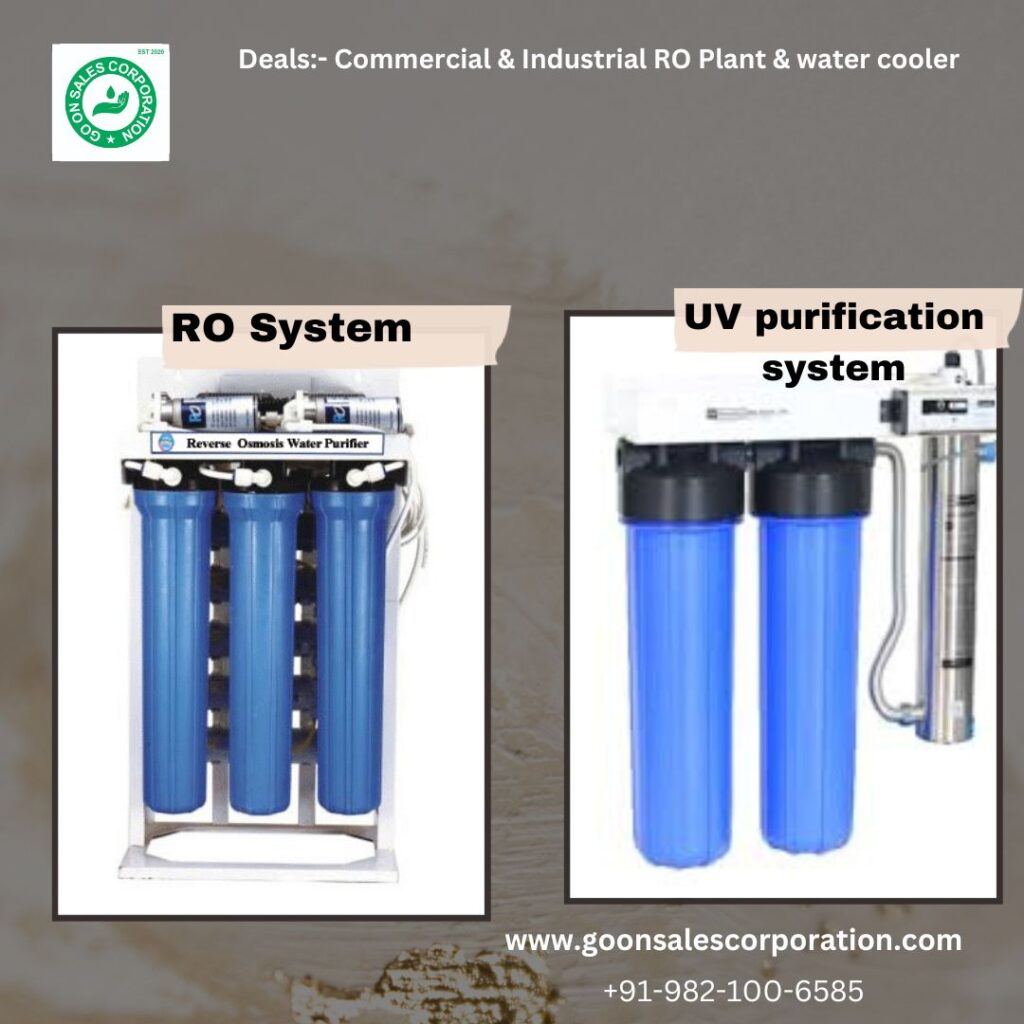
Introduction
What is the difference between the RO system & UV purification system which is best? Let’s learn and clarify.
Water purification is essential for ensuring clean, safe drinking water. Two of the most common water treatment methods are Reverse Osmosis (RO) and Ultraviolet (UV) systems. Let’s explore the differences between these two technologies and which might be the best for your water purification needs.
- RO systems use a semi-permeable membrane to remove many contaminants, including dissolved salts, minerals, and even some microorganisms.
- The membrane acts like a filter, allowing water molecules to pass through while blocking larger, unwanted particles.
- RO systems are effective in removing up to 99% of various impurities, making the water cleaner and safer to drink
Ultraviolet (UV) System:
UV systems use powerful UV light to kill or inactivate harmful microorganisms, such as bacteria, viruses, and protozoa, without the use of chemicals.
- The UV light disrupts the DNA of these microorganisms, preventing them from reproducing and causing illness.
- UV systems are effective in eliminating up to 99.99% of waterborne pathogens, making the water microbiologically safe.
- UV systems require minimal maintenance, as they do not have any filters or membranes that need to be replaced regularly
How Does RO Purification Work?
The RO process works by applying pressure to the water, forcing it through the semi-permeable membrane. As the water passes through the membrane, the contaminants are left behind, and the purified water is collected on the other side.
RO systems are designed to remove up to 99% of the following contaminants
- Dissolved salts and minerals (e.g., sodium, calcium, magnesium)
- Heavy metals (e.g., lead, mercury, arsenic)
- Bacteria and viruses
- Pesticides and other organic compounds
- Nitrates and nitrites
By effectively removing these impurities, RO systems can produce water that is clean, crisp, and free from the majority of contaminants, making it safe for drinking and various household uses.
Advantages of RO Water Purification
- Comprehensive Contaminant Removal: RO systems are highly effective in removing a wide range of contaminants, including dissolved solids, heavy metals, and microorganisms, ensuring the water is safe for consumption.
- Improved Taste and Odor: By removing dissolved minerals and other impurities, RO systems can improve the taste and odor of the water, making it more enjoyable to drink.
- Versatility: RO systems can be used to purify water from various sources, including tap water, well water, and even brackish or seawater, making them a versatile solution for different water quality concerns.
- Consistent Performance: RO systems maintain a consistent level of purification, providing a reliable supply of clean, safe water over time.
- The disadvantage of RO Water Purification
- Water Waste: RO systems typically produce a small amount of wastewater during the purification process, which can be a concern in areas with limited water resources.
- Mineral Removal: While the removal of dissolved minerals is an advantage for some users, it can also be a drawback, as it can result in the loss of beneficial minerals in the water.
- Maintenance Requirements: RO systems require regular maintenance, such as replacing the membrane and filters, to ensure optimal performance and efficiency.
- Energy Consumption: RO systems can be more energy-intensive compared to some other water purification methods, which may impact operating costs.
Understanding Ultraviolet (UV) Water Purification
Ultraviolet (UV) water purification is a technology that uses powerful UV light to kill or inactivate harmful microorganisms, such as bacteria, viruses, and protozoa, without the use of chemical disinfectants.
- UV water purification systems use a specialized UV lamp that emits high-intensity UV light. As the water passes through the system, the UV light disrupts the DNA of microorganisms, preventing them from reproducing and causing illness.
UV systems are highly effective in eliminating up to 99.99% of waterborne pathogens, making the water microbiologically safe for consumption. Unlike RO systems, UV systems do not remove dissolved minerals or other non-microbial contaminants from the water
Advantages of UV Water Purification
- Effective Disinfection: UV systems are highly effective in killing or inactivating a wide range of harmful microorganisms, including bacteria, viruses, and protozoa, without the use of chemicals.
- No Chemical Residues: UV purification does not introduce any chemical disinfectants into the water, which can be beneficial for those who prefer a more natural approach to water treatment.
- Low Maintenance: UV systems generally require less maintenance compared to other water purification technologies, as they do not have any filters or membranes that need to be replaced regularly.
- Energy Efficiency: UV systems are typically more energy-efficient compared to some other water purification methods, which can help reduce operating costs.
The disadvantage of UV Water Purification
- Limited Contaminant Removal: UV systems are designed to target and eliminate microbiological contaminants, but they do not remove dissolved minerals, heavy metals, or other non-microbial impurities from the water.
- Turbidity Sensitivity: The effectiveness of UV purification can be reduced if the water has high levels of turbidity (suspended particles), as these can interfere with the UV light’s ability to reach and disinfect the microorganisms.
- Lack of Residual Protection: Once the water has passed through the UV system, it does not have any residual disinfection properties, meaning it is not protected from potential recontamination.
- Potential for Scaling and Fouling: Over time, the quartz sleeve that surrounds the UV lamp can become coated with scale or fouling, reducing the system’s effectiveness and requiring regular maintenance.
Differences Between RO and UV Water Purification Systems
Now that we have a better understanding of how RO and UV water purification systems work, let’s explore the key differences between the two:
- Contaminant Removal:
- RO systems can remove a broader range of contaminants, including dissolved solids, minerals, heavy metals, and even some microorganisms..
- Effectiveness:
- RO systems are highly effective and capable of removing up to 99% of various contaminants.
- UV systems are also highly effective and capable of eliminating up to 99.99% of waterborne pathogens.
- Maintenance Requirements:
- RO systems require more frequent maintenance, such as replacing the membrane and filters, to ensure optimal performance.
- UV systems generally require less maintenance, as they do not have any filters or membranes that need to be replaced regularly.
- Energy Consumption:
- RO systems can be more energy-intensive compared to UV systems, which are generally more energy-efficient.
- Wastewater Production:
- RO systems typically produce a small amount of wastewater during the purification process.
- UV systems do not generate any wastewater, as they do not use a physical separation process.
- Mineral Removal:
- RO systems can remove beneficial minerals from the water, which may be a concern for some users.
- UV systems do not remove dissolved minerals, leaving them intact in the purified water.
- Recontamination Protection:
- RO systems provide a physical barrier against potential recontamination after the purification process.
- UV systems do not have any residual disinfection properties, so the water is not protected from potential recontamination after it has passed through the system.
Which is the Best Water Purification System?
The choice between an RO or UV water purification system ultimately depends on your specific water quality concerns and requirements. When deciding which system is best for your needs, consider the following factors:
- Contaminant Removal Requirements:
- If you need to remove a wide range of contaminants, including dissolved solids, minerals, and heavy metals, an RO system may be the better choice.
- If your primary concern is eliminating microbiological contaminants, such as bacteria and viruses, a UV system could be a more suitable option.
- Water Usage and Conservation:
- If you have concerns about water waste or live in an area with limited water resources, the wastewater produced by an RO system may be a drawback.
- In such cases, a UV system, which does not generate any wastewater, could be a more environmentally friendly choice.
- Mineral Content Preferences:
- If you prefer to maintain the beneficial minerals in your water, a UV system may be a better option, as it does not remove these minerals.
- Conversely, if you prefer water with a lower mineral content, an RO system can provide that.
- Maintenance and Operating Costs:
- UV systems generally require less maintenance and are typically more energy-efficient, which can lead to lower operating costs in the long run.
- RO systems, on the other hand, may have higher maintenance requirements and energy consumption, potentially resulting in higher operating costs.
In many cases, a combination of RO and UV technologies can provide the most comprehensive water purification, ensuring your water is clean, safe, and free from a wide range of impurities. This hybrid approach can leverage the strengths of both technologies to address a variety of water quality concerns.
Ultimately, the best water purification system for your needs will depend on your specific water quality issues, budget, and personal preferences. Consulting with a water treatment professional can help you make an informed decision and determine the optimal solution for your home or business.
Call us for any type requirement of RO & water coolers @ 9821006585, Email.go.onsales20@gmail.com

